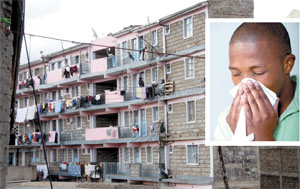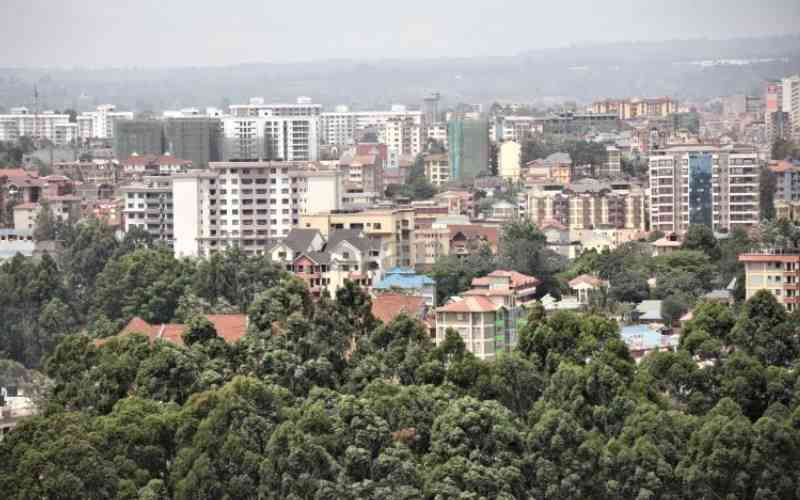Cases of respiratory diseases have been rising in Nairobi’s Embakasi area. Experts blame this on the sick building syndrome, which is as result of inappropriate building materials and lack of ventilation. ALLAN OLINGO explores this phenomenon
Do you constantly have headaches, eye or skin irritation, sniffles, sneezes, dry cough, fatigue, dizziness or even flu? You could be suffering from the effects of a poorly constructed house.
Some houses are either built using inappropriate materials or are too close to one another, leading to lack of ventilation and poor lighting.
 |
Poor ventilation is the main cause of the sick building syndrome. Constructors should adhere to ventilation standards in the Building Code to avoid this condition. |
"Walking into a modern building can sometimes be compared to placing your head inside a plastic bag filled with toxic fumes," says John Bower, an author of several books on healthy home construction.
Sick building syndrome is a term used to describe situations in which building occupants experience acute health and discomfort effects that appear to be linked to time spent in a building, but no specific illness or cause can be identified.
Last month, the Director of City Planning and Nairobi City Council, Tom Odongo, alluded to a study that has shown that more and more people in Nairobi’s Embakasi area are suffering from respiratory diseases.
This syndrome is common in many low-income residential areas in Nairobi because of the limited or no spacing between buildings, which leads to poor ventilation.
Also, Nairobi being a swampy area, especially the plains of Eastlands, there is always the risk of damp raising, where water seeps into the walls, causing dampness in rooms. Using chemicals in a poorly ventilated building can also be hazardous.
Occupation certificate
"From the way a building is designed to the materials used for its finishes — whether it is the wooden floor or paint on its walls — the causes of sick buildings are frequently pinned down to flaws in the ventilation, level of dampness or air conditioning," explains University of Nairobi don and environmental design expert, architect Musau Kimeu.
According to Architectural Association of Kenya chairman Stephen Oundo, this problem has several faces and the blame lies either with the developer, the professions employed by the developer or the approving authorities.
Oundo says most of the city developments do not have an occupation certificate and, therefore, their human habitation status cannot be verified.
Having an occupation certificate shows that the building is suitable for occupancy. City councils or Municipal councils issue this certificate to show that a building has been built in compliance with the Building Code.
Kimeu, who is the chairman of the Environmental Design Consultants Chapter of the Architectural Association of Kenya, adds that dampness in your house causes mould, potentially causing allergic reactions and respiratory problems.
In the office, you find that employees get symptoms such as eye, nose and throat irritation as well as neurotoxic or general health problems.
Kimeu, notes that the main cause of such discomfort is poor indoor air quality, which is as a result of poor ventilation.
Chemical contaminants
Says Kimeu: "The big challenge of course is for everyone to understand why these symptoms occur. There are times you walk into the office and you start having a headache, dry cough or feeling dizzy and too tired to execute your work. It could be because of a sick building."
A World Health Organisation report suggested that up to 30 per cent of new and renovated buildings worldwide may be linked to the symptoms of sick building syndrome.
Kimeu says that apart from inadequate ventilation, sick building syndrome can be attributed to chemical contaminants like volatile organic compounds (VOCs) from office machines, carpets and furniture as well as biological contaminants like bacteria, moulds, dust mites and viruses. These can cause acute effects on the occupants of a building.
These biological contaminants may breed in stagnant water that has accumulated in ducts or ceiling tiles, which may in turn lead to symptoms like cough, chest tightness, fever, chills, muscle aches, and allergic responses such as mucous membrane irritation and upper respiratory congestion.
What then can be done to correct this? Oundo says cross ventilation should be incorporated in building designs to increase air circulation and ensure proper ventilation.
"This can be done by having windows on opposite sides of the room, resulting in free airflow across the space," explains Kimeu.
Oundo also says ventilation standards in the Building Code should be adhered to and this can be achieved through proper and transparent enforcement by the relevant local authorities.
Kimeu, on the other hand, says it is important for architects to ensure there is sufficient natural ventilation in buildings and for users to ensure there is no contamination through dampness or water spillage.
"Nairobi’s tropical upland climate is so good that all buildings, if properly designed, can be naturally ventilated," says Kimeu.
There are also those building materials that are toxic in nature and architects should specify non-toxic building materials that have been tested and approved.
Cross ventilation
Kimeu says part of the problem is that developers want to use new materials, mostly from China and other parts of Asia, which have not been tested over time and proven to be safe and suitable to our local conditions. Many of these new materials are being dumped in our country and their toxic status is still not well established or documented.
"The new National Planning and Building Regulations spell out what needs to be done to achieve indoor air quality. It is a requirement that every major construction material should be researched, its chemical make up analysed and the material then chosen or rejected on its environmental and indoor air quality impact. The regulations also specify the use of non-toxic materials, which would eliminate the element of materials being flooded into our market from Asia," says Kimeu.
"We need space buffers between buildings so that the circulation of air is all round. This will enable cross ventilation," says Charles Karisa, an urban planner and lecturer in the Department of Urban and Regional Planning, University of Nairobi.
The most important thing is the orientation of building, which enhances ventilation.
The building should be able to tap the wind and so wind direction is critical in design.
This kind of deficiency is not limited to residential houses, but is also common in office buildings.
Kimeu says the Central Bank engaged Triad Architects in 2002 to investigate a problem of employees complaining that they experienced constant headaches during morning hours.
"We found out that ventilation through the building’s central court had been blocked after it was roofed. This meant that whenever drivers rewed the engines of cars parked in the court in the morning, the exhaust fumes would not be let out of the building. It would instead get into the building’s upper floors through the windows facing the court. The workers would then inhale these fumes and hence the symptoms," says Kimeu.
Green buildings
He says they corrected the problem by redesigning the roof to allow for natural ventilation. Three months later, Kimeu received a positive report.
Oundo explains that if the authorities would implement the Building Code to the letter by inspecting and approving buildings, sick building syndrome would be a thing of the past.
Going green in building design can address the sick building syndrome by solving problems of inadequate ventilation, chemical and biological contaminants as well as determine the choice of materials used in a building.
In an earlier interview with Home & Away, Felix Kiptum, a renewable energy expert with United Nations Industrial Development Organisation said green buildings avoid many of these problems by incorporating healthy ventilation systems and use of non-toxic building materials.
"Green buildings ensure there is good ventilation and thus things like dampness due to poor ventilation do not happen," explains Kimeu.
"When designing in the tropics, the biggest problem is prevention of heat build up from the sun and provision of cooling inside the building. This is achieved by having the correct building orientation with windows facing north and south and no windows to the eastern and western facing facades.
 The Standard Group Plc is a multi-media organization with investments in media
platforms spanning newspaper print operations, television, radio broadcasting,
digital and online services. The Standard Group is recognized as a leading
multi-media house in Kenya with a key influence in matters of national and
international interest.
The Standard Group Plc is a multi-media organization with investments in media
platforms spanning newspaper print operations, television, radio broadcasting,
digital and online services. The Standard Group is recognized as a leading
multi-media house in Kenya with a key influence in matters of national and
international interest.
 The Standard Group Plc is a multi-media organization with investments in media
platforms spanning newspaper print operations, television, radio broadcasting,
digital and online services. The Standard Group is recognized as a leading
multi-media house in Kenya with a key influence in matters of national and
international interest.
The Standard Group Plc is a multi-media organization with investments in media
platforms spanning newspaper print operations, television, radio broadcasting,
digital and online services. The Standard Group is recognized as a leading
multi-media house in Kenya with a key influence in matters of national and
international interest.










